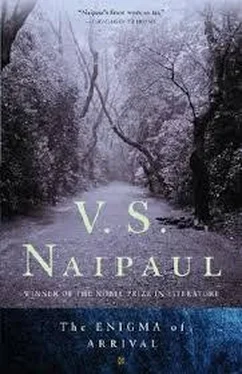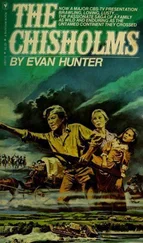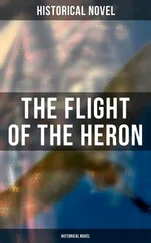V. Naipaul - The Enigma of Arrival
Здесь есть возможность читать онлайн «V. Naipaul - The Enigma of Arrival» весь текст электронной книги совершенно бесплатно (целиком полную версию без сокращений). В некоторых случаях можно слушать аудио, скачать через торрент в формате fb2 и присутствует краткое содержание. Год выпуска: 2012, Издательство: Picador, Жанр: Современная проза, на английском языке. Описание произведения, (предисловие) а так же отзывы посетителей доступны на портале библиотеки ЛибКат.
- Название:The Enigma of Arrival
- Автор:
- Издательство:Picador
- Жанр:
- Год:2012
- ISBN:нет данных
- Рейтинг книги:3 / 5. Голосов: 1
-
Избранное:Добавить в избранное
- Отзывы:
-
Ваша оценка:
- 60
- 1
- 2
- 3
- 4
- 5
The Enigma of Arrival: краткое содержание, описание и аннотация
Предлагаем к чтению аннотацию, описание, краткое содержание или предисловие (зависит от того, что написал сам автор книги «The Enigma of Arrival»). Если вы не нашли необходимую информацию о книге — напишите в комментариях, мы постараемся отыскать её.
The Enigma of Arrival — читать онлайн бесплатно полную книгу (весь текст) целиком
Ниже представлен текст книги, разбитый по страницам. Система сохранения места последней прочитанной страницы, позволяет с удобством читать онлайн бесплатно книгу «The Enigma of Arrival», без необходимости каждый раз заново искать на чём Вы остановились. Поставьте закладку, и сможете в любой момент перейти на страницу, на которой закончили чтение.
Интервал:
Закладка:
T HE LANE that led up the hill to the new barn and then down to the cottages and old farm buildings, the lane beside the windbreak of beech and pine and the subsidiary hedge of field rose and hawthorn, had grown rough and broken. You could easily have turned your ankle on it. The new farm management began to have that lane mended.
Men and machines came one week, and a level black layer of mixed asphalt and gravel was quickly laid down, in a few days. The black color and the machine finish looked new and unnatural next to the tufted grass of the verges. But the surface that had been so quickly laid down was meant to last: as if in pledge of that, the yellow board of the road makers was set up on the public road, just before the lane, and one end of the board was cut into a directional arrow.
I didn’t like the change. I felt it threatened what I had found and what I had just begun to enter. I didn’t like the new busyness, the new machines, the machine lopping of the hawthorn and wild rose which left them looking damaged. And I didn’t want that new surface on the farm lane to hold.
I looked for cracks and flaws in it and hoped that the little abrasions and water erosions I noticed would spread and make it impossible — fantasy taking over from logic — for the machines to lay down a new asphalt mixture. Of course I knew my fantasy was fantasy: though the farm was set among ruins of many sorts, reminders of the impermanence of men’s doings, there was another side to men’s work. Men came back, men went on, men did and did again. How small the caravels were that crossed the Atlantic and intruded into the evenness of history on the other side; how few the men in those small vessels, how limited their means; how barely noticed. But they went back. They changed the world in that part forever.
So though the new asphalt layer was crushed here and there into dips by the tractor wheels; and though the rain, running down the hill, sought out every weakness and crack in the dips and dug out minute bits of asphalt from between small stones and then dug more deeply into the loosened surface, and the irregular edge of the surface was undermined by water running down in little channels (miniatures of the larger channels of which our valley was a relic) between the hard black crust and the soft, grass-covered earth, though there were these things that made me feel that the lane might be reduced again to the rocky, uneven condition in which I had first found it, yet the lane was made good, and then made good again, and withstood the winter, which came fiercely that year.
There was a blizzard on Christmas day, with the wind blowing from the northwest. I found, when I went out in the early afternoon, that the snow had been blown into a drift in the windbreak. A bank of snow, then, beside the lane; and in the lee of every tree trunk, every sturdy twig, every obstacle, there was a sharp ridge that indicated the direction of the wind.
The shape and texture of this snow drift reminded me of a climate quite different: of a Trinidad beach where shallow streams — fresh water mingled with salt, salt predominating or lessening according to the tides — ran from tropical woodland to the sea. These streams rose and subsided with the tide. Water flowed now from the sea to the pools of the woodland river, now in the other direction. At every low tide the streams cut fresh channels in the freshly laid sand, created fresh sand cliffs, which then, when the tide began to rise again, fell neatly, segment by clean segment, into the rippled current: a geography lesson in miniature. To me as a child these streams always brought to mind the beginning of the world, the world before men, before the settlement. (Romance and ignorance: for though there were no longer aboriginal people on the island, they had been there for millennia.)
So the texture and shapes and patterns of the snow here on the down in the windbreak and in its lee created, in small, the geography of great countries. Like the little rivulets that ran between the steep grass verge and the new asphalt crust of the lane. And this geography in miniature was set, as I thought, or as I liked to think, in a vaster geography. The valley of the droveway between the smooth low hills spoke of vast rivers hundreds of yards across, flowing here in some age now unimaginably remote: a geography whose scale denied the presence of men. There would have been a brimming river or flow all the way from Stonehenge (and the plain beyond) to Jack’s cottage and then along the droveway with the beehives and the caravan and stone shell of a house and farm manager’s bungalow and suburban-style garden; there would have been a river all there, a flat gray flow, debouching into or filling the valley of the present river, a remnant, small-scale, human, beside which I sometimes walked and where people now fished for trout, released by keepers. In that vast geography created by the miniature landscape, and the fantasy of the droveway as river channel, there was no room for men; that vision was a vision of the world before men.
Beyond the brow of the hill the wind was keen; shelter was no longer provided by the hill or the windbreak. A livid gray sky, a gray but warm dirtiness, hung over the great plain, where the barrows were like pimples: the stone circles lost in the snow, blurring the view at the edges, no sight of the colored artillery targets. At the bottom of the hill, among the farm buildings (made monumental by the snowfall), was the dead cottage of Jack: snow lying on the ground about it (the droveway there normally so muddy and black) like a great clean thing, like a remaking of the world.
The snow made for hard walking. But weather like this in this usually mild valley revived in me a wish for extremes, though it was the cold and the damp and the wet that had carried away Jack. His damaged lungs, in that damp valley bottom, had denied him warmth even in the summer. (Something else, of course, if there had been no cold or damp, would have carried him away.)
On my early walks, after having my fill of the Henge and the barrows, I had looked for hares on one slope. Then, on another hill, at another season I had looked for larks, trying to keep them in sight as they rose and rose, lift upon lift, and watching for them as they dropped down. Now I looked for deer. A family of three had appeared in the valley, coming from no one knew where, and surviving in our well-tilled, well-grazed valley, dangerous over large tracts with military gunfire, crossed at many places by busy highways, surviving among us no one knew how.
They, the deer, had their run too. And it was in the hope of seeing them — in addition to my excitement at the snow and the wind — that I tramped round the farm buildings and up the droveway to the point from which there was a view of the wood and the untilled open slope where the deer sometimes grazed. And unbelievably — my Christmas reward! — they were there, in the snow. Usually, against the wood, the deer were hard to see; lower down, against the chalky green and brown of the bare slope, they were reddish-brown, warm, but they had to be looked for. Now (like the rabbits of my very first week, coming out to feed on the lawn in front of my cottage) the deer were dirty-looking, gray, dark against the snow, easy marks for anyone who wished to knock them off.
I longed for those deer to survive. And they did. Towards the end of the winter I discovered one in the wilderness at the back of my cottage, in the marshland beside the river. He was a young deer and I caught sight of him one morning, all eyes, among the beaten-down brown reeds. And there for many mornings in succession I saw him. I stood on the rotting bridge over the black creek and looked. The secret, then, to see him, to keep him where he was, was to hold his eyes and to be still oneself. As long as you looked, he looked; as soon as you moved or made a gesture he was away, running at first through the reeds and tall grass and then giving the lovely leap that could take him clear over fences and hedges.
Читать дальшеИнтервал:
Закладка:
Похожие книги на «The Enigma of Arrival»
Представляем Вашему вниманию похожие книги на «The Enigma of Arrival» списком для выбора. Мы отобрали схожую по названию и смыслу литературу в надежде предоставить читателям больше вариантов отыскать новые, интересные, ещё непрочитанные произведения.
Обсуждение, отзывы о книге «The Enigma of Arrival» и просто собственные мнения читателей. Оставьте ваши комментарии, напишите, что Вы думаете о произведении, его смысле или главных героях. Укажите что конкретно понравилось, а что нет, и почему Вы так считаете.












